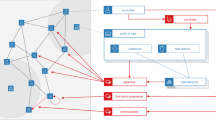Abstract
As for consumer’s strategic behaviors in the marketing sales, this paper improves the cost function and demand function in the Stackelberg dynamic game model, discusses the influence that brought by the parameter change in the model with the numerical simulation and detects the optimal decision methods among enterprises. The research shows that under the Bertrand-Stackelberg game, the time delay will cause the follower enterprise’s commodity lower than that of the leader enterprise, but the discount coefficient has no influence on the leader enterprise’s pricing; under the Stackelberg game, the follower enterprise’s market share will increase remarkably with the expansion of the R&D input scale; moreover, the enterprise’s R&D input scale is positively related to the commodity price, but the follower enterprise’s R&D input scale has negative effect on the leader enterprise’s commodity price.











Similar content being viewed by others
References
Amir, R.: Modelling imperfectly appropriable R&D via spillovers. Int. J. Ind. Organ. 18(7), 1013–1032 (2000)
Baines, T.S.A., Lightfoot, H.W.A., Evans, S.A., Neely, A.A., Greenough, R.A., Peppard, J.A., et al.: State-of-the-art in product-service systems. J. Eng. Manuf. 221(10), 1543–1552 (2007)
Ballestin, F., Valls, V., Quintanilla, S.: Scheduling projects with limited number of preemptions. Comput. Oper. Res. 36(11), 2913–2925 (2009)
Cachon, G., Swinney, R.: Purchasing, pricing, and quick response in the presence of strategic consumers. Manage. Sci. 55(3), 497–511 (2009)
Chioveanu, I.: Price and quality competition. J. Econ. 107(1), 23–44 (2012)
Ellis, A.W., Holmes, S.J., Wright, R.L.: Age of acquisition and the recognition of brand names: on the importance of being early. J. Consum. Psychol. 20(1), 43–52 (2010)
Elmaghraby, W., Keskinocak, P.: Dynamic pricing in the presence of inventory considerations: research overview, current practices, and future directions. Manage. Sci. 49(10), 1287–1309 (2003)
Hellofs, L.L., Jacobson, R.: Market share and customers’ perceptions of quality: when can firms grow their way to higher versus lower quality? J. Mark. 63(1), 16–25 (1999)
Huang, S., Yang, Y., Anderson, K.: A theory of finitely durable goods monopoly with used-goods market and transaction costs. Manage. Sci. 47(11), 1515–1532 (2001)
Joglekar, N.R., Levesque, M.: Marketing, R&D, and startup valuation. IEEE Trans. Eng. Manage. 56(2), 229–242 (2009)
Karmarkar, U.S., Pitbladdo, R.C.: Quality, class, and competition. Manage. Sci. 43(1), 27–39 (1997)
Lambertini, L., Orsini, R.: Quality improvement and process innovation in monopoly: a dynamic analysis. Oper. Res. Lett. 43, 370–373 (2015)
Levin, Y., Mcgill, J., Nediak, M.: Dynamic pricing in the presence of strategic consumers and oligopolistic competition. Manage. Sci. 57(4), 1737–1751 (2009)
Levin, Y., Mcgill, J., Nediak, M.: Optimal dynamic pricing of perishable items by a monopolist facing strategic consumers. Prod. Oper. Manag. 19(1), 40–60 (2010)
Li, H., Ji, Y., Gu, X., Qi, G., Tang, R.: Module partition process model and method of integrated service product. Comput. Ind. 63(4), 298–308 (2012)
Liu, Q., Zhang, D.: Dynamic pricing competition with strategic customers under vertical product differentiation. Manage. Sci. 59(1), 84–101 (2013)
Marcus, B., Anderson, C.K.: Revenue management for low-cost providers. Eur. J. Oper. Res. 188(1), 258–272 (2008)
Piga, C., Poyago-Theotoky, J.: Endogenous R&D spillovers and locational choice. Reg. Sci. Urban Econ. 35(2), 127–139 (2005)
Reibstein, D.: A broader perspective of network effect. J. Mark. Res. 46(2), 154–156 (2009)
Schmidt, R.C.: On the robustness of the high-quality advantage under vertical differentiation. J. Ind. Compet. Trade 6(3–4), 183–193 (2006)
Xie, G., Yue, W., Wang, S., Lai, K.K.: Quality investment and price decision in a risk-averse supply chain. Eur. J. Oper. Res. 214(2), 403–410 (2011)
Yu, M., Debo, L.G., Kapuscinski, R.: Strategic waiting for consumer-generated quality information: dynamic pricing of new experience goods. Manag. Sci. 62(2), 410–435 (2016)
Yue, J., Austin, J., Wang, M., et al.: Coordination of cooperative advertising in a two-level supply chain when manufacturer offers discount. Eur. J. Oper. Res. 168(1), 65–85 (2006)
Zhang, Z., Joseph, K., Subramaniam, R.: Probabilistic selling in quality-differentiated markets. Manag. Sci. 61(8), 1959–1977 (2015)
Zeithaml, V.A., Berry, L.L.: Communication and control processes in the delivery of service quality. J. Mark. 52(2), 35–48 (1988)
Zeithaml, V.A.: Consumer perceptions of price, quality, and value: a means-end model and synthesis of evidence. J. Mark. 52(3), 2–22 (1988)
Acknowledgements
This work was supported by the National Science Foundation for Young Scientists of China (71602041).
Author information
Authors and Affiliations
Corresponding author
Rights and permissions
About this article
Cite this article
Qi, N., Jian-yu, Z. & Yong-hong, M. The optimization and simulation analysis of the enterprise’s decision making system with the interference of the consumption strategy. Cluster Comput 22 (Suppl 2), 2835–2850 (2019). https://doi.org/10.1007/s10586-017-1600-2
Received:
Revised:
Accepted:
Published:
Issue Date:
DOI: https://doi.org/10.1007/s10586-017-1600-2




